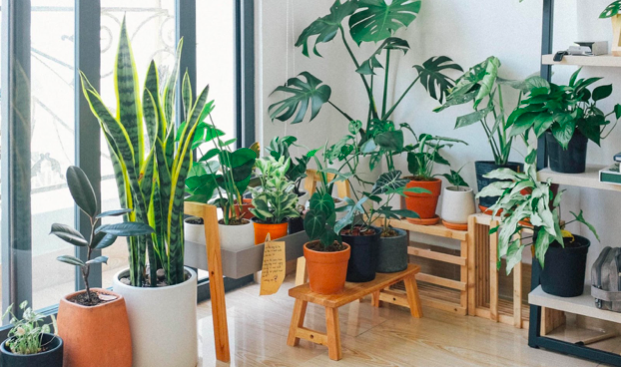
-Naomi Austin-
It’s obvious that houseplants are becoming big again. Back in the 70s everybody had their basic spider plant and pothos, and that was pretty much the extent of it. Nowadays there are plant-obsessed groups online devoted to all different types of varieties of houseplants and their care, whether it be rare or standard varieties. People are absolutely filling their houses with green plants, and no wonder! They improve the oxygen quality of your home, reduce allergies, and bring a feeling of life to your home. I get it – it’s easy to get super addicted to houseplants. But what happens when one of your plants starts to die or starts to show signs of stress? Here’s a brief list of the top 6 problems that I hear about from customers that come into the shop with houseplant issues.
Overwatering
This is honestly what we hear about the most in the shop. People that are so desperate to make sure their house plants don’t die that they actually end up killing them with kindness by overwatering. The most common sign of overwatering will be rotting/melting leaves. If the overwatering has caused root rot, then sometimes you will see yellowing of the leaves as well or a softening of the stem or base of the plant.
So how do we fix this? Water less or put your plant in a smaller pot. You always need to match the type of plant that you have to its watering needs rather than trying to fit your plant into your watering schedule. So in other words, if you have different kinds of plants, don’t water them all the same amount once per week. Some plants need more water, some plants need less. Learn about your particular plants’ specific needs, or ask us when you come by for a visit. We’re happy to guide you. Sometimes plants are repotted into pots which are much larger than their needs, putting them in a situation where the roots cannot absorb the water fast enough and rot. So either ask us about this when you come by to purchase your plant or have us repot it for you when you buy the plant from us.
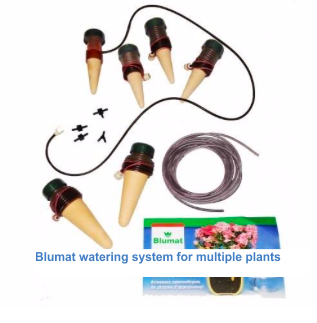
One handy tool you can use to keep your plants properly watered at all times is an automatic watering system, like Blumat kits. These self-waterers automatically dispense just the right amount of water to your plants , using gravity and wicking. Blumats are also great for watering your plants when you go on vacation, or otherwise can’t do your regular watering. Blumats are available as systems for multiple plants, or you can buy individual self-waterers for individual plants.
Spider mites
These pests…. uuuugh. They are the bane of any plant lover’s existence. Even experienced plant lovers at some point or another will get spider mites. It’s just a fact. They happen. They’re horrible. But if you know what to look for, you can at least stop them before they kill your infested plant or spread to other plants.
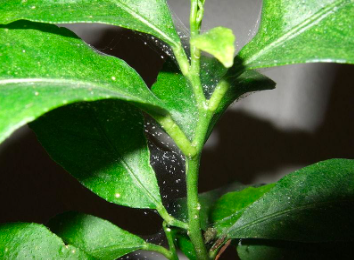
So what are we looking for? Well, often times spider mites go unnoticed because people think that the webs they are seeing are spiderwebs. You’ll see a little tiny web on your plant and think “Oh that’s cute, there’s a little house for a spider there. The spider is so small I can’t even see it” (or, maybe your thought is “eek” if you hate spiders). Only it isn’t a spider, most of the time. Usually, it will be these little nasty mites that spin little tiny webs and put little tiny eggs all over your plant and soil. If you look at those cute little spiderwebs close enough, those things that look like dust stuck in the spider web, you’ll see the dust moving because it’s not dust, it’s the mites. Those little tiny bugs are slowly sucking the life out of your plant, so you need to get rid of them. ASAP.
The product I always recommend is called Flying Skull Nuke ‘Em Insecticide and Fungicide. I like it because it’s OMRI listed (organic), and you really only have to use it once. You have to spray down the whole plant top to bottom all over and the soil to make sure it’s saturated. The good news is that every egg and mite which that liquid hits will die within 24 hours. If the infestation is very bad to the point of coming close to killing your plant, then I suggest treating it once more a few days later to make sure that you actually did hit every egg and every mite.
Mealy Bugs
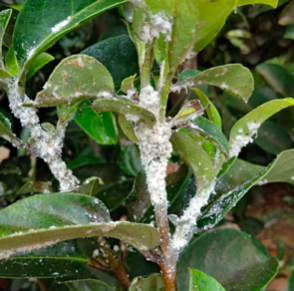
These are a common problem we see. People usually think they’re aphids or some sort of webbing because they kind of look like cotton ball puffs on your plants and in the cruxes of your leaves in branches. But they’re actually soft bodied insects that are sucking the life out of your plant, once more. These are a lot easier to take care of then spider mites, thankfully. All you have to do is hit them with a little bit of alcohol on a q-tip to kill the actual mealybugs that you see, and then spray down the plant with some insecticidal soap to kill the tiny ones. I would treat it again after a week to make sure that you got all of the hatchlings, as the insecticidal soap will not kill the eggs. After that, just adjust the watering routine for the plant and try to give it some nutrients, as usually this issue is caused by plant stress. However, sometimes an infestation can also be caused by ants, which will literally carry the mealy bugs to your plants and harvest the sweet liquid from their bug butts. So get rid of any ants you may have in the home as well. You’re welcome. 😬
Fungus Gnats
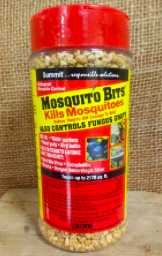
Fungus gnats are annoying but not dreadfully problematic for your house plants. They usually are caused by over-watering. Wet soil is a perfect breeding ground for these little tiny flies that breed in the soil. Generally speaking, if you have fungus gnats you’re probably over-watering your house plant no matter what house plant it is. You can let the soil dry out. Once the soil dries out and is completely dry for a day or so, the fungus gnats should go away. However if this is not an option for you, or this does not work, then we recommend a product like Mosquito Bits. This product is made from a naturally-occuring bacteria that kills the gnat larva, stopping the life cycle. You can also top-dress your plants with rice hulls, which prevent gnats.
If you don’t stop overwatering, however, then it’s a lost cause using this bacteria because you will eventually get the gnats back again and will have to retreat the soil. So try to adjust the watering routine for a longer-term solution.
Under-watering
This is another common issue that’s generally caused by people sticking to an inappropriate watering schedule, not researching a plant’s specific watering needs, and/or forgetting to water their house plants. The signs and symptoms of under watering are usually dryness and browning of the tips of the plants, drooping of the plants, a lack of leaf luster when they once had sheen, and leaf drop of green leaves on the plant. The most common plants that I see this on are usually peace lilies, succulents, monstera, spider plants, water hungry tropicals, and ferns. it’s hard to advise you how to water your plant without knowing what kind of plant it is, so I just say look up the plants and make sure you actually do give them the water that they need. No cheating. Cheating kills plants. Oh yeah, and stick to filtered water, distilled water, or rain water if you can. Tap water contains chlorine and fluoride which are terrible to use on any plant, but especially tropical plants.
Not sure you can give your plant enough water? Those Blumats I mentioned above, as well as glass self-watering globes can help you keep your plants properly hydrated, either when you go out of town, or on the regular.
Nutrient Deficiencies
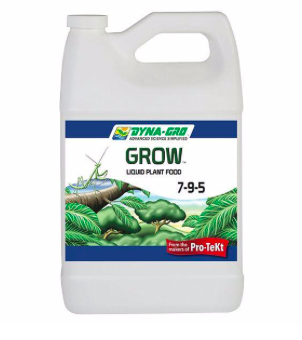
It’s really hard to talk about nutrient deficiencies because there are so many of them and the signs are so different for each plant. To summarize though, I will say that if your plants start showing discoloration, drooping, or leaf drop when it is not caused by any of the above things I listed then it’s probably being caused by a nutrient deficiency. The solution is easy which is just to give your plant the appropriate house plant fertilizer. We generally recommend Dyna Gro: Grow for houseplants, but if it’s a blooming type, then we might recommend a different type of fertilizer. We are happy to talk with you about which fertilizer is best for your collection of plants.
I hope this helped out! Whatever the problem is with your houseplants please don’t give up on them, and please don’t give up on your love of plants just because one or two of them have died. Remember that they are plants. It’s OK to lose a couple. It’s all part of the learning process, and with time and patience you will get better at learning their needs! If that means that you have to stick to the easy plants, so be it! There is no shame in knowing your limits of care and time for your plants. The key is asking the right questions so that you know what your plants need and how to get that to them. So, please, ASK US. We are always happy to help you succeed!

bandar judi sbobet terbesar says
Exceptional post. Didn’t know this, appreciate it for letting
me know.
Genevieve says
Hi! This info is very helpful.
Especially the Blumat watering kit since I’m worried about my office plants in this time of COVID-19. I’m hoping you can help identify a pest that’s been eating my Dieffenbachia. It looks like a tiny, black leech and leaves silvery dead patches where it feeds. I remove them manually, but more appear every few days. Oh, and they ‘jump’ when I try to touch them sometimes.
(I’m in NYC).
Thanks for any help you can offer.
Doralea Kendricks says
I have a creeping charlie plant about 5-6 years old. It once was a houseplant but in the last 4 years changed it to outside plant. In the last couple of months I,ve noticed that if you pull a bad leaf off a rust colored fluid that stains your fingers comes out. Also the edged of leaves are slightly yellowing, then some of new leaves are pucking or bubbling instead of flat leaf. I live in the central Arizona about 3300 ft. Can you tell me whats wrong with my plant?
Kelly says
Hi. So ,I have 2 arrowhead plants. ( All indoor) and a curly spider. As well as about 8 basil that my mom potted from her garden last summer. And yes, she rooted them at her house, potted them. They had no pests. Plenty of time went by between her house and mine ,no pests. Anyway, oddly, all my indoor plants started really growing, beginning of fall! Weird, they continued to throu the 1st part of winter. I had baby spider clippings, arrowhead too. Etc etc. All of a sudden. Boom! Spider plant had ,i think mealy bugs? It was dead and manly within ?,couple weeks. The arrowheads, idk. Bronze is leggy. Green is bushy. But the spider plant died. My basil got severely infested too. They were all in a ,either different room, sum just xcrss the room from houseplants. The spider suddenly started regrowing. Nature! I stare, at home 24/7, at them. Idk. Im quickly writing
I saturated it with soap/water. Then. It’s fine. Then suddenly thyr back! Basil is demolished,I’m actually scared to touch it. Bugs all over. Like all different kinds at once. Spider will be fine. Suddenly, the White little things are back. Sum are yellowish. I am done with plants. Im waiting for mom to take her pots back, but ,i have Nowhere to dump dirt and plant so i go throu process of caring, then bugs are back..
Im confused.
ashley says
Yes, bugs can seem to come out of nowhere and do great. damage very quickly! When things get too infested, sometimes the best thing is to pitch the plant and soil; clean and disinfect the pot; and start again. Horticultural oils like neem oil are good preventatives you can spray on your plants to stop an infestation from starting.
51 Game Original says
I found this post incredibly helpful! I never realized how common spider mites were until you explained their signs. The treatment tips were easy to follow, and I can’t wait to try the neem oil remedy. Thanks for sharing such valuable information!